Recently at my physical therapy appointment my doctor gave me some new exercises and also gave me some progressions for exercises I was already doing to heal my back. My goal with PT was to fix my back pain, but more importantly to get back to the activities I love (biking, running, yoga, kettlebells). My therapist said that if you want to run, you should be doing a few specific exercises on a frequent basis.
Want to be a runner and not have to deal with frequent/chronic injury? She said you should be doing the glute bridge exercise and be able to hold a plank for 60 seconds. And maintain those goals. Both exercises will keep your core strong and stabilize your hips during running; in turn it will keep Runner’s Knee and low back pain away. Sold. Sign me up!
I wanted to share what I am currently doing to improve my body. So far the exercises seem to be helping a lot!
Glute Bridge
The glute bridge exercise might sound familiar to you. It’s a yoga move and common in PT. There are so many benefits to this exercise but the biggest one for me is that stronger glutes fix my runner’s knee. Period. It also helps stabilize your core and helps alleviate low back pain. I’ve been given this exercise before but in the past, even though I did it diligently, I never really felt a difference. I mentioned that to my therapist and she suggested this variation:
One simple change– doing it on your heels instead of with your feet flat– made a HUGE difference for me. Suddenly I FELT the exercise in my butt and glutes when I did it this way. This is now the only way I do it. And I feel it after I’m done, too. It’s important to engage your core, tighten your glutes and hold them as you go up and down. If not, you’re not getting the same benefits. I love this move. I feel it the next day! I also found a website with examples of other variations I may try in the future.
One Leg Glute Bridges
This is a variation of the basic glute bridges the physical therapist is having me do. It’s supposed to be harder than the traditional way, and it is! Here is a short video of the demonstration.
Like the regular glute bridge, do it on your heel. When I first tried it at physical therapy I was like, Oh holy moly this is a LOT harder. I sure did feel it! My doc said the leg doesn’t need to be straight out (like the above picture), just raised. The important keys: do it on your heels, engage your pelvic floor while you do it, and then make sure your hips are staying level as you raise them. If you’re twisting the raised hip, you’re not getting the benefits. And probably messing up the low back.
One Leg Romanian Deadlift
I’ve written about this move before. It’s a must for me when I want to keep Runner’s Knee away from my life. It was a regular part of my weight lifting workout for a long time. When I had my back flare up I stopped doing this move (and most weight lifting) and it didn’t take long for my knees to start to act up. 🙁
When my therapist watched me do this exercise the one correction she made was to have me hold the weight (or kettlebell) in one hand instead of holding two. Then put the free hand on the small of your back as you bend over. This helps you to make sure you aren’t raising/twisting your hip as you bend. I was! Granted I usually do the move in front of a mirror to make sure I don’t twist, but it’s easy to twist and then there’s no point in the exercise because you putting strain on your lower back. Good to know!
Plank
I know, I know, love/hate relationship right? Planks suck. They are hard. But when you finish doing them you feel accomplished! My therapist suggested doing the plank on the elbows instead of hands (it will be harder that way) and to make sure that you are engaging your core muscles while you hold it otherwise you are putting pressure on your low back. Especially if your back is sagging in any way. I see that a lot in the gym–people doing a plank (side plank, traditional etc) and they are sagging. Do it in front of a mirror if necessary to hold it!
Clam
This exercise is one I’ve been given for pretty much every running injury I’ve gotten. This move is supposed to help strengthen your hips. I didn’t always like it because I never really “felt” it. I tried it with a stretchy rubber PT band and that helped a LITTLE bit…but still, didn’t really feel it when I did the exercise. Recently my therapist suggested I try a different way to do it. I hope I can describe it properly…
So same position as the photo below (minus the band). Except instead of having the knees and feet touching, she had me raise the higher leg so it was parallel to the leg resting on the floor and THEN do the clam move. So the legs aren’t actually touching as you do the move, but you’re still doing the same form. If that makes sense? Okay, if it does, good. Because this variation was much better! I could feel the exercise doing it this way.
So far it’s been working. I think the combination of the standing desk and doing the PT exercises during my workouts on a regular basis have helped my back AND my knees! I also started doing the cobra/up-dog yoga stretch after each set of kettlebell swings. It helps a lot!
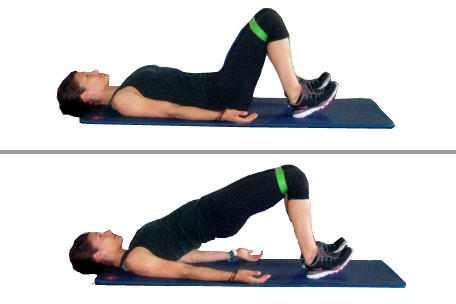
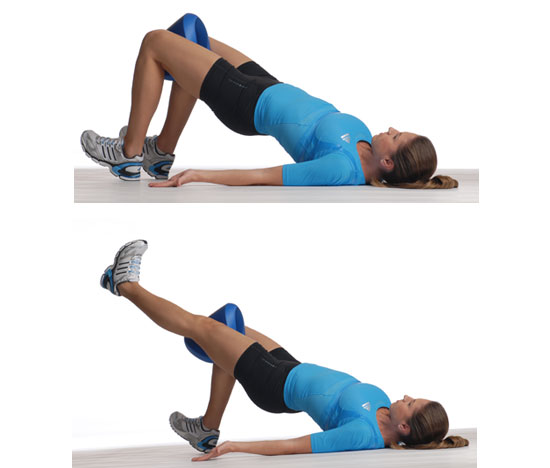
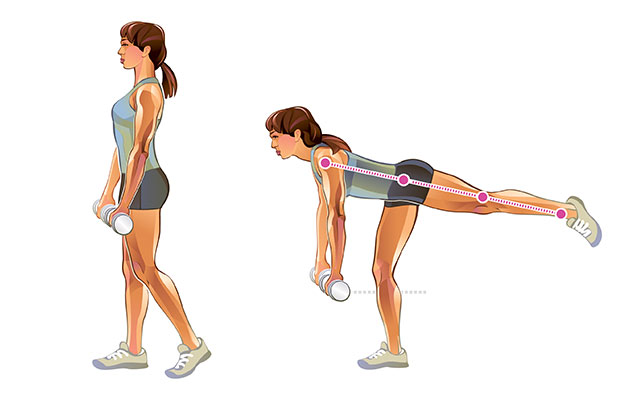
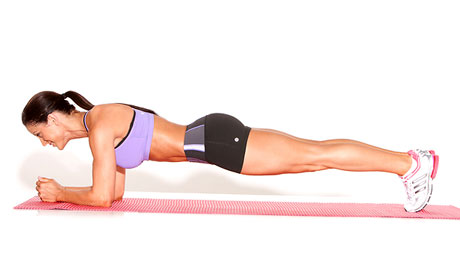
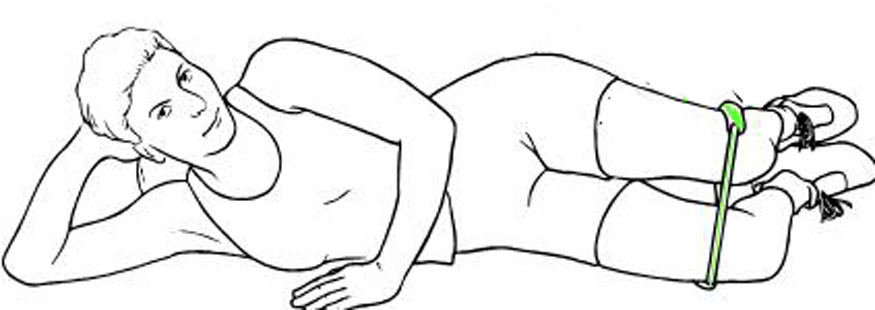
emmaclaire
I’ve been behind in my blog reading and got caught up on the past couple of weeks today. Thanks for continuing to post your eats periodically – I love the idea of blueberries and cottage cheese for a snack! Thank you also for the above exercise ideas. They are all very commonsense, but, when you get out of the habit of doing them it’s easy to forget how much they help. I’m just now getting back to the point in my running where I’m starting to feel a twinge in the glutes, and I know I need to get bridges and clams back into my routine.
Lisa Eirene
It’s a tasty snack! And pretty low in calories, too.
Yep! I’m with you. You start to feel better and stop doing the exercises that helped you get better…it’s a good reminder to incorporate them into your workouts (which is what I’m doing). Then the PT doesn’t really feel like work, it’s just another activity I’m doing in the gym.
Biz
Since I’ve been doing my Classical Stretch 3 times a week, knock on wood, I haven’t had any problems with my knees or feet – it’s on my local PBS station –
http://www.classicalstretch.com/
Hope you have a great weekend!
Lisa Eirene
Thanks for the tip!
Correy Smith
Those glute bridges sure sounds familiar to what the physical therapist has been recommending my wife to do. After her previous accident of falling off from a ladder my wife has been on the recovery. Her injury is what got us worried especially for the race that she was going to be participating in a couple of month.
Drew
Running takes a whole new kind of toll on your body so stretches like these are going to keep you moving longer. Using a mirror is a good tip to keep good form. Thanks so much for sharing!
Jonathan Pound
Thanks for your tips on injury prevention and running. I used to run 7 miles every day; until I got IT Band syndrome. I had to go to the physical therapist twice for it. Now I make sure that I include some injury prevention exercises and stretches, just like you do. Thanks again.
Andre Beluchi
Lisa, looking at the pictures of all the exercises that you got from physical therapy it seems like all of them have you arch your back. By arching your back, does that straighten out the spine or just put a relieve on the spine? I ask this because of my aunt’s situation where she too was injured when she fell off a ladder from her roof.
Lisa Eirene
I don’t think you are supposed to arch your back in those specific exercises. Like the glute bridge, you keep your core stable and straight and raise your body using your glutes.
Veronica Marks
It’s good to know that sagging while planking can put pressure on the back. I didn’t realize that, and I definitely have been sagging a bit while doing my planks. I don’t want to injure my back because I’ve had previous injuries. I’ll be sure to follow your advice and do planking in front of a mirror until I get it right!
Lisa Eirene
Yep! Form is crucial, especially when it comes to things that can strain your back!
Andre Beluchi
Lisa, so would these exercises that you posted help out with stretching out a damaged hamstring or calf? If so, then it would be something for me to maybe talk to my sister about. Since she would need some type of massage therapy to heal her injured leg.
Lisa Eirene
It’s definitely worth talking to a physical therapist about!
Drew
Great tips for recovering from running injuries. Staying dedicated to your recovery will get you back on the road much faster. Thanks so much for sharing!
Lisa Eirene
Thanks!
Elden Gatley
I agree that the one-legged glute bridge is hard, but an amazing workout for injuries. It allows the muscles to strengthen in a special way. It’s also easy on the joints.
Selene
Awesome post, those are certainly some great exercises to try out! Physical therapy can be so helpful and give you information you can use the rest of your life. Thanks for sharing!